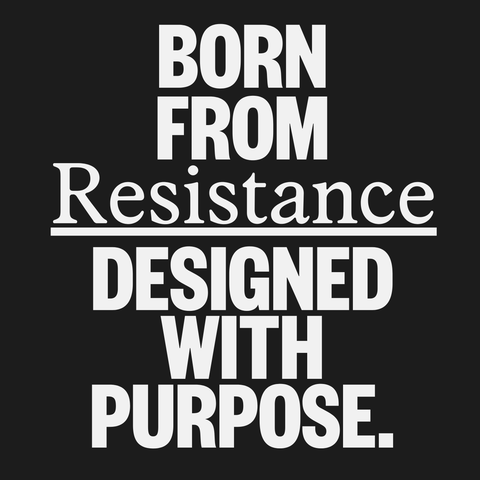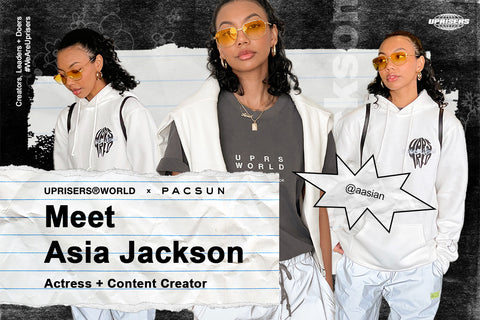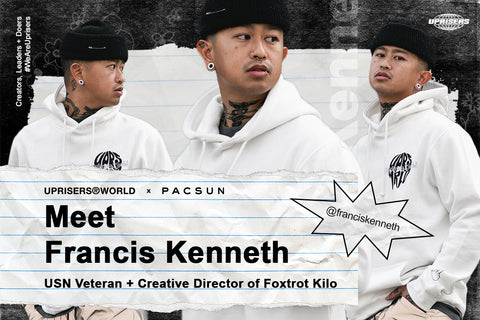The artist breaks down his inspirations and how he started posting thriving content.
Grab your pen and notebook, it's time we have a really good conversation on art history. With over 8 million likes on Tiktok, we already know Dane will not disappoint. He's changing the whole paradigm of art history from an exclusive, invite-only to a more accessible everyone interested is welcome approach.
The Hawaii-local, bucket hat finessing artist is changing our lives and "for you page" for the better. As if the news couldn't get any more exciting, he's now uploading to his Youtube channel. We caught up with Dane, better known as umeboi, about all things art history and representation in art. Continue reading for the full conversation.
UPRISERS: How and when did you get connected with UPRISERS?
Dane Nakama: Actually, I was reached out to by Kari Okubo, we knew each other through family- friends and also through TikTok engagement. I got to know Kari over the past year. But Michelle specifically I met her through Kari like last month or two months ago.
What inspires you to share your art and talk about social issues on social media?
Yeah, well, it's kind of funny because I started off with TikTok because I wanted a hobby outside of art because literally everything I do is art. But then I made one video about art analysis and it kind of went viral. I love talking about art, but I think a big part of it for me was that a lot of our education and our culture is reserved for a very small group of people and a privileged few. It's because that education is not widely accessible. And so for me, growing up, I loved art history, but I knew that not a lot of people had the same kind of pathways or interest in the resources that were available, which were primarily just textbooks and really boring lectures. My goal was really just to expand that discourse and make education of the arts more accessible so that more people can feel like they belong in the museum or can speak to this history. I just wanted to have more people to talk to, whereas if no one else knows the language that you speak, you try to share that language so that you have someone to speak with.
What made you interested in art?
So I actually started making art when I was really, really young like five years old. I just didn't call it art at the time. I would make my own toys because it was kind of out of I like to say creative necessity. Where literally the characters I liked on TV shows, I watched a lot of old Japanese Power Ranger shows that they didn't have toys for because they were so old or they were so niche or, you know, the side characters no one paid attention to I thought were really cute and identified with. So I made my own little sculptures. Since then I kind of started understanding the world and making relationships through the process of making. As early as I can remember, art has facilitated the way in which I learn and approach understanding other people. So, yeah, it's that's kind of the origin story.
As far as like the work I make now, I'm definitely more interested in dismantling the high art of academia, where it's like: oh, art can be cute, it can be approachable, it can be enticing, but also still very conceptual and rigorous.

From the comments and feedback you received, was there a moment you realized you were making a difference?
I love engaging with the community because one thing or there's so many things that it's completely reframed the way I look at art and people in the world primarily. It's those comments where the person who thought all contemporary art was kind of just a bunch of bull crap but then watching my videos they're like: oh, maybe I should give it a second chance. I think a really exciting thing for me with arts education specifically a lot of people are, you know, groomed to believe that it's right or wrong. It's yes or no. It's one answer and one answer only. But specifically with the arts and humanities in general, that's never the case. You know, it's never one answer. So like being able to tell people in the comments section or through videos and be like: look, this is how I interpret the work. I'm not saying that's how you will. I'm not saying that's how another person will. But the point is, the closest thing we are to the truth is when we admit there's no one answer.
There's one person who messaged me that their mother had to drop out of college because they had them, but they were pursuing an art history degree and now they share my videos with their mom and it totally brought back all of her passions. There's other people who have messaged me like, I'm going back to school for art history because I love your content. And I'm like, that's amazing. I'm not even in art history major. I'm an artist, so it's kind of crazy that that happens.
What are you most looking forward to with the PacSun collection?
I am really excited by the UPRISERS collab in general because, for me, when I was first introduced to UPRISERS, I was kind of taken aback by seeing a brand that centered itself around underrepresentation or underrepresented voices and social engagement and progress. I think it's often we see companies kind of do their own thing and they're like: oh, we're also engaged in social activism. Whereas UPRISERS social activism is the core value– the brand develops around that and not engagement.
And that, to me, is really exciting because it also like from an artist standpoint, I think acknowledging that to be a core value in any sense is something that should happen and and hasn't been happening. I'm really excited that with this collaboration people will be able to see more voices in these shops. I'm imagining what it would be like for me as a kid to walk into a shop and see there's someone who is queer, artist in PacSun. Like, that's crazy. You know, I feel like I would have felt a lot less alone.
What is one of your hopes for your personal audience?
If I'm really honest, I too am a byproduct of a very Eurocentric art history. And because that's really just the resources a lot of people are presented with. But the moments like people are like: oh, can you do more videos on women artists who are so underrepresented or like Southeast Asian artists or like deaf artists? Because so often, we don't see ourselves in history, but now it's the time to be like, well, history accounts for all the telling of the story, not just one. What I like about PacSun is acknowledging that different narratives exist right now.







